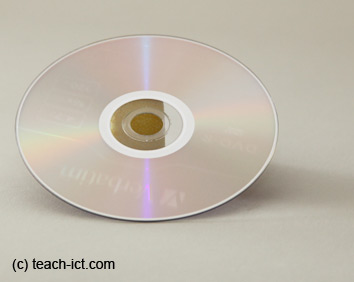7. Compact Disks
Compact disks are known as optical storage devices.
Data is burned onto the surface of the disk using a laser beam in the CD drive. A laser beam is also used to read the data stored on the disk.

A CD can store around 650 Mb of data. A typical MP3 song is about 3Mb and so a CD can hold about 200 songs.
Compact Disks come in two main forms:
CD-ROM - CD Read Only Memory. Data can only be written once i.e. once the pits are burnt on to the surface, that part of the disk cannot be used again for storage although it can be re-played endless times. Most music discs are of this format.
An old-fashioned name for this is CD-WORM meaning Write-Once-Read-Many but it is hardly a common description these days. You can store more than one data session on a single disk. This is called a 'multi-session' option. This simply means the burner allocates another part of the disk to the next 'session'. CDROMs are more popular than CD-RW because they are so cheap - a few pence each.
CD-RW - CD ReWriteable. This means that you can save data to your disk over and over again, but they are more expensive than the standard CDROM and a USB memory stick can hold much more data in any case.
| Advantages of CDs | Disadvantages of CDs |
|---|---|
| Small and portable | Fairly fragile, easy to snap or scratch |
| Very cheap to produce | Smaller storage capacity than a hard drive or DVD |
| Most computers can read CDs. If there is no CD drive, a DVD drive can usually read them | Slower to access than the hard disk. |
| Fairly fast to access the data - quicker than magnetic tape |
| Property | Notes |
|---|---|
| Type of storage | Optical |
| Data access | Direct access |
| Cost of storage | CDs cost more per byte of storage than DVDs, hard disks, magnetic tapes or flash memory |
| Capacity | 650 Megabytes |
| Speed | Slower than a hard disk or flash memory, faster than magnetic tape |
| Portability | Fairly portable. Too large to fit into a pocket, but will easily fit inside a bag. Can be carried between home/school/office. |
| Durability | Easily scratched by general wear and tear or by not protecting it in a plastic case. Scratches on the disk surface can damage the data being stored Needs to be protected from extremes of heat. The CD-RW version has a limited number of read/write cycles. |
| Reliability | If scratched, the data might not be able to be read. Needs a computer with a CD or DVD drive in order to read the disk. |
Challenge see if you can find out one extra fact on this topic that we haven't already told you
Click on this link: Compact Disk
